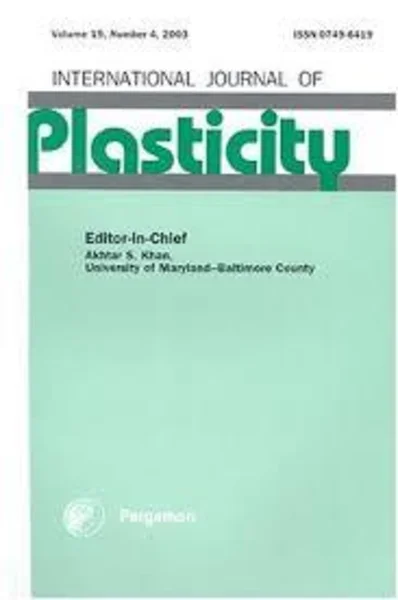-
effects of crystal content on the mechanical behaviour of polyethylene under finite strains: experiments and constitutive modelling
جزئیات بیشتر مقاله- تاریخ ارائه: 1390/01/01
- تاریخ انتشار در تی پی بین: 1390/01/01
- تعداد بازدید: 710
- تعداد پرسش و پاسخ ها: 0
- شماره تماس دبیرخانه رویداد: -
the mechanical stress–strain behaviour of polyethylene (pe) materials under finite strains is studied both experimentally and theoretically. in order to gain insight into the structure and physical properties of investigated pe materials, a series of thermal (dsc and dmta) and microstructural (small-angle x-ray scattering and afm) characterizations have been undertaken. the influence of crystallinity on the various features of the tensile stress–strain response is considered over a large strain range, implying thermoplastic-like to elastomer-like mechanical behaviour. a physically-based hyperelastic–viscoplastic approach was adopted to develop a pertinent model for describing the mechanical behaviour of pe materials under finite strains. the semicrystalline polymer is being treated as a heterogeneous medium, and the model is based on a two-phase representation of the microstructure. the effective contribution of the crystalline and amorphous phases to the overall intermolecular resistance to deformation is treated in a composite framework, and coupled to a molecular network resistance to stretching and chain orientation capturing the overall strain hardening response. in order to extract the individual constitutive response of crystalline and amorphous phases, a proper identification scheme based on a deterministic approach was elaborated using the tensile test data of pe materials under different strain rates. comparisons between the constitutive model and experiments show fair agreement over a wide range of crystallinities (from 15% to 72%) and strain rates. the constitutive model is found to successfully capture the important features of the observed monotonic stress–strain response: the thermoplastic-like behaviour for high crystallinity includes a stiff initial response, a yield-like event followed by a gradual increase of strain hardening at very large strains; for the elastomer-like behaviour observed in the low crystallinity material, the strain hardening response is largely predominant. strain recovery upon unloading increases with decreasing crystallinity: this is quantitatively well reproduced for high crystallinity materials, whereas predictions significantly deviate from experiments at low crystallinity. model refinements are finally proposed in order to improve the ability of the constitutive equations to predict the nonlinear unloading response whatever the crystal content.
مقالات جدیدترین رویدادها
-
استفاده از تحلیل اهمیت-عملکرد در ارائه الگوی مدیریت خلاقیت سازمانی و ارائه راهکار جهت بهبود
-
بررسی تاثیر ارزش وجوه نقد مازاد بر ساختار سرمایه شرکت های پذیرفته شده در بورس اوراق بهادار تهران
-
بررسی تأثیر سطح افشای ریسک بر قرارداد بدهی شرکت های پذیرفته شده در بورس اوراق بهادار تهران
-
بررسی تأثیر رتبه بندی اعتباری مبتنی بر مدل امتیاز بازار نوظهور بر نقد شوندگی سهام با تأکید بر خصوصی سازی شرکت ها
-
تأثیر آمیخته بازاریابی پوشاک ایرانی بر تصویر ذهنی مشتری پوشاک ایرانی (هاکوپیان)
-
تبیین نقش کاربردی فرهنگ و آموزه های اسلامی بر کالبد معماری مسکن در ایران
-
مدل شناختی - رفتاری داگاس برای اختلال اضطراب فراگیر
-
تحلیل و بررسی تزیینات وابسته در معماری اسلامی با تاکید بر نقوش اسلیمی و هنر خوشنویسی و جایگاه آن در معماری امروز
-
بررسی تحلیل های دینامیکی استاندارد 2800 و مقایسه تا روش قابلیت اعتماد سازه ها در تعیین بیشینه جابه جایی نسبی
-
development of electronic and electrical materials from indian ilmenite
مقالات جدیدترین ژورنال ها
-
مدیریت و بررسی افسردگی دانش آموزان دختر مقطع متوسطه دوم در دروان کرونا در شهرستان دزفول
-
مدیریت و بررسی خرد سیاسی در اندیشه ی فردوسی در ادب ایران
-
واکاوی و مدیریت توصیفی قلمدان(جاکلیدی)ضریح در موزه آستان قدس رضوی
-
بررسی تاثیر خلاقیت، دانش و انگیزه کارکنان بر پیشنهادات نوآورانه کارکنان ( مورد مطالعه: هتل های 3 و 4 ستاره استان کرمان)
-
بررسی تاثیر کیفیت سیستم های اطلاعاتی بر تصمیم گیری موفق در شرکتهای تولیدی استان اصفهان (مورد مطالعه: مدیران شرکتهای تولیدی استان اصفهان)
-
بررسی و شناخت دعاوی قابل سازش در نظام حقوقی ایران
-
شناسایی اولویت بندی موانع پیاده سازی کنترل داخلی موفق در شرکت های شهرک صنعتی استان فارس
-
شناسایی و رتبه بندی عوامل کلیدی موفقیت مدیریت کیفیت زنجیره تامین در شرکت های آسانسوری شهر سنندج
-
بررسی رابطه میزان پرخاشگری و انزوا اجتماعی دانشجویان تاریخ و علوم تربیتی دانشگاه فرهنگیان لرستان پردیس آیت الله کمالوند
-
بازخوانی سیر تحولات مرمت و توسعه مسجد جامع بروجرد




سوال خود را در مورد این مقاله مطرح نمایید :